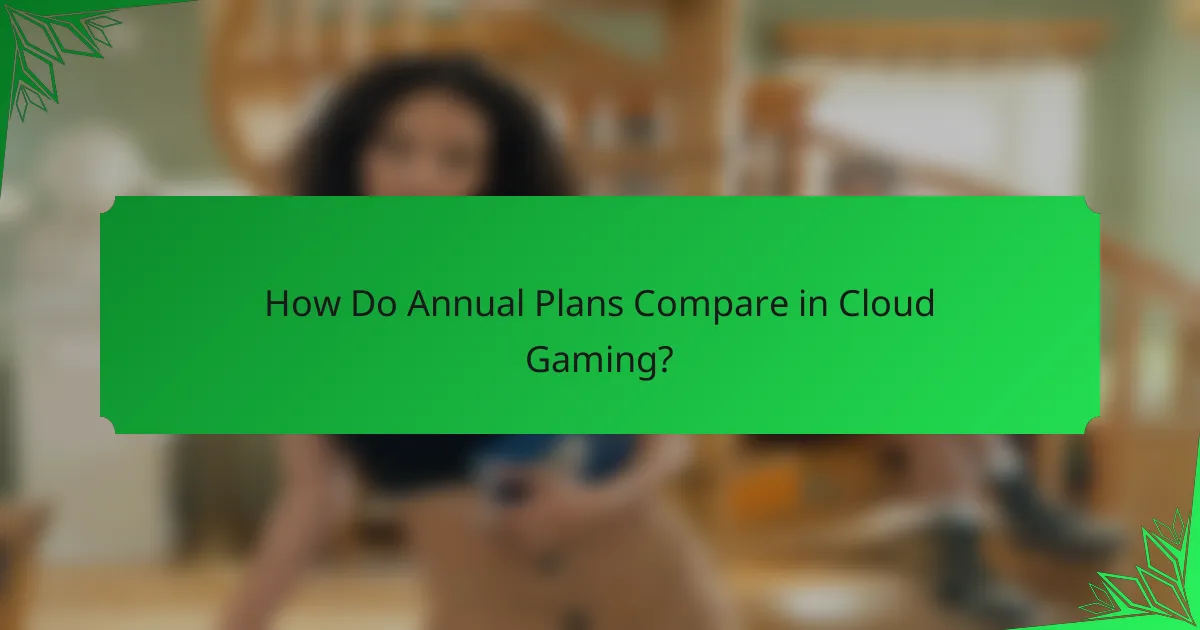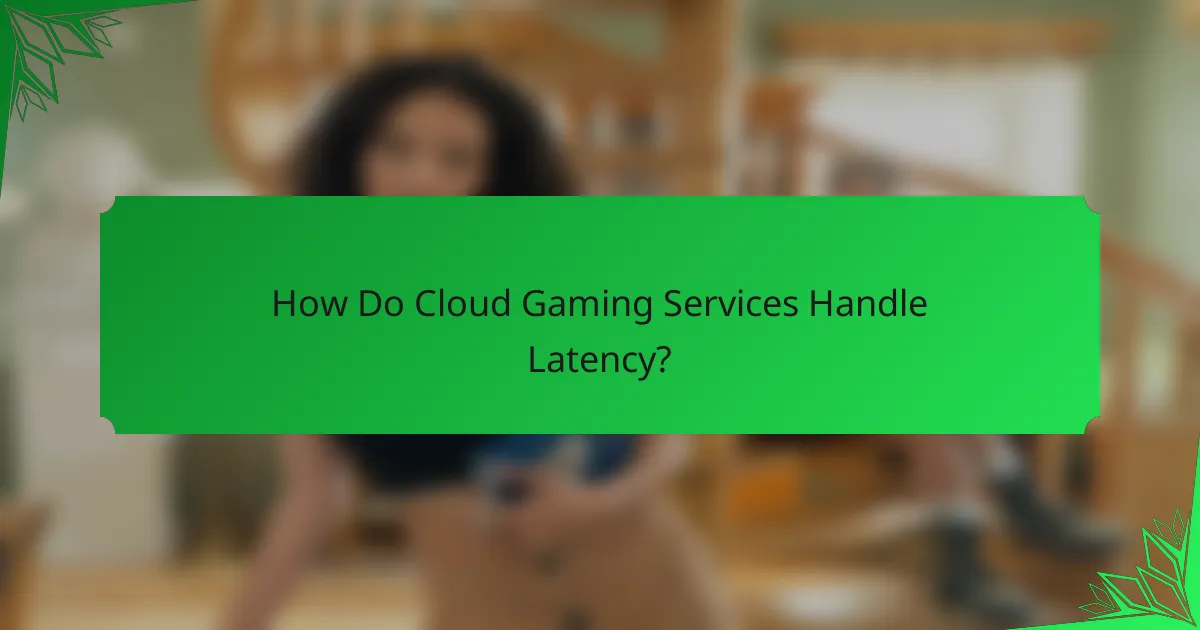Cloud gaming has revolutionized the way we access and enjoy video games, offering flexible monthly and cost-effective annual plans that cater to diverse gaming preferences. These subscription models allow players to stream a vast library of games without the need for expensive hardware, making gaming more accessible. By employing effective budgeting strategies, gamers can navigate these options to enhance their experience while staying within their financial means.

What Are the Best Cloud Gaming Monthly Plans?
The best cloud gaming monthly plans offer flexibility and access to a wide range of games without the need for expensive hardware. These plans typically allow users to stream games directly to various devices for a monthly fee, making gaming more accessible and budget-friendly.
NVIDIA GeForce NOW
NVIDIA GeForce NOW allows users to stream games they already own on platforms like Steam and Epic Games Store. The service offers a free tier with limited session lengths and a paid subscription that provides longer play sessions and access to higher performance servers.
Monthly plans start at around $9.99, which grants priority access and extended session times. Users should consider their game library and whether they prefer to purchase games outright or subscribe to services that include titles.
Xbox Cloud Gaming
Xbox Cloud Gaming, part of the Xbox Game Pass Ultimate subscription, enables players to access a large library of games on various devices. This service is particularly beneficial for those who already own an Xbox console, as it integrates seamlessly with their existing library.
The monthly cost is approximately $14.99, which includes access to hundreds of games. It’s advisable to check the game library regularly, as titles may rotate in and out, affecting long-term access to favorite games.
PlayStation Plus Premium
PlayStation Plus Premium offers cloud gaming as part of its subscription service, allowing users to stream a selection of PS4 and PS5 games. This plan is ideal for PlayStation fans looking to enjoy classic and new titles without needing to download them.
Monthly subscriptions start at around $17.99. Users should evaluate the available game catalog to ensure it aligns with their gaming preferences, as the selection can vary significantly.
Google Stadia
Google Stadia provides a cloud gaming platform where users can purchase games individually or subscribe to a service for access to a library of titles. While Stadia offers a free tier, the Pro subscription enhances the experience with higher resolution and exclusive discounts.
The Pro plan costs about $9.99 per month, but users should be aware that they still need to buy games separately. Consider the overall cost of ownership when evaluating this option, as it may not be the most economical for casual gamers.
Amazon Luna
Amazon Luna is a cloud gaming service that allows users to play games across various devices via a subscription model. It features different channels, including a library of games for a flat monthly fee, making it easy to access a variety of titles.
Starting at around $5.99 per month for the Luna+ channel, this service is budget-friendly. Users should explore the available channels and their game offerings to find the best fit for their gaming habits and preferences.

How Do Annual Plans Compare in Cloud Gaming?
Annual plans in cloud gaming typically offer significant cost savings compared to monthly subscriptions, making them an attractive option for dedicated gamers. By committing to a full year, users often benefit from lower overall fees and additional perks.
Cost Savings of Annual Subscriptions
Annual subscriptions can save gamers anywhere from 10% to 30% compared to paying monthly. For example, if a monthly plan costs around $10, an annual plan might be priced between $100 and $120, translating to substantial savings over time.
Additionally, some services provide exclusive discounts or bonuses for annual subscribers, such as free game access or premium features, further enhancing the value of long-term commitments.
Popular Annual Plans
Several cloud gaming platforms offer competitive annual plans. Services like NVIDIA GeForce NOW, Xbox Cloud Gaming, and PlayStation Now frequently feature annual options that cater to various budgets and gaming preferences.
For instance, NVIDIA GeForce NOW offers an annual plan priced at approximately $99.99, while Xbox Cloud Gaming can be bundled with Xbox Game Pass for around $180 annually, providing access to a vast library of games.
Benefits of Long-Term Commitment
Committing to an annual plan not only reduces costs but also ensures uninterrupted access to gaming services. This stability allows gamers to dive deeper into their favorite titles without worrying about monthly renewals.
Moreover, long-term subscribers often receive priority customer support and early access to new features, enhancing their overall gaming experience. This commitment can foster a sense of community among players who share similar gaming interests and preferences.

What Budgeting Strategies Work for Cloud Gaming?
Effective budgeting strategies for cloud gaming help manage subscription costs while maximizing gaming experiences. By understanding monthly and annual plans, gamers can make informed decisions that align with their financial goals.
Monthly Budgeting Tips
To effectively budget for monthly cloud gaming subscriptions, start by determining how much you can allocate each month. Consider setting aside a specific amount, such as $10 to $30, depending on the services you wish to use.
Be mindful of promotional offers that may provide initial discounts. However, always check the renewal rates to avoid surprises. Prioritize subscriptions based on the games and services that matter most to you.
Annual Budgeting Considerations
Annual plans often offer significant savings compared to monthly subscriptions, sometimes reducing costs by 15-20%. Evaluate whether committing to a yearly plan aligns with your gaming habits and preferences.
Before opting for an annual plan, assess your gaming schedule for the year. If you anticipate limited gaming time, a monthly plan may be more economical. Always compare the total annual cost against your expected usage to make the best choice.
Tracking Subscription Costs
Tracking your cloud gaming subscription costs is essential for maintaining your budget. Use budgeting apps or spreadsheets to monitor expenses and set reminders for renewal dates.
Consider creating a simple list of all your subscriptions, including their costs and renewal dates. This will help you identify any unnecessary services and make adjustments as needed. Regularly reviewing your subscriptions can prevent overspending and ensure you get the most value from your gaming budget.

What Are the Key Features to Consider in Cloud Gaming Plans?
When evaluating cloud gaming plans, consider factors such as game library size, streaming quality, and device compatibility. These features significantly impact your gaming experience and overall satisfaction with the service.
Game Library Size
The size of the game library is crucial as it determines the variety of titles available for play. Many services offer hundreds to thousands of games, but the specific genres and new releases can vary widely. Look for platforms that frequently update their libraries to keep the selection fresh.
Additionally, consider whether the service includes exclusive titles or popular franchises that you enjoy. Some platforms may focus on indie games, while others may prioritize blockbuster hits, so choose one that aligns with your gaming preferences.
Streaming Quality
Streaming quality affects how smoothly games run and how visually appealing they are. Most cloud gaming services offer varying resolutions, typically ranging from 720p to 4K, depending on your internet speed and subscription tier. A higher resolution can enhance the gaming experience but may require a faster internet connection.
Latency is another critical factor; aim for services that maintain low latency, ideally under 50 milliseconds, to ensure responsive gameplay. Testing your internet connection before committing to a plan can help you gauge whether you can achieve the desired streaming quality.
Device Compatibility
Device compatibility is essential for accessing cloud gaming services on your preferred hardware. Most platforms support a range of devices, including PCs, consoles, smartphones, and smart TVs. Check the specific requirements for each service to ensure your devices are supported.
Some services may offer dedicated apps for mobile devices, while others rely on web browsers. If you plan to game on multiple devices, look for a service that allows seamless transitions between them without losing progress.

How Do Cloud Gaming Services Handle Latency?
Cloud gaming services manage latency by relying on a combination of internet speed, server proximity, and user setup. Lower latency is crucial for a smooth gaming experience, as it reduces the delay between player actions and game responses.
Impact of Internet Speed
Internet speed significantly affects latency in cloud gaming. A higher bandwidth allows for faster data transmission, which is essential for real-time gaming. Ideally, a minimum download speed of 15 Mbps is recommended for a decent experience, while speeds above 25 Mbps are preferable for high-quality graphics and responsiveness.
Moreover, upload speed is also important, especially for multiplayer games where your actions need to be communicated to the server. Aim for an upload speed of at least 5 Mbps to ensure smooth gameplay.
Server Locations
The physical distance between the gamer and the cloud gaming server plays a critical role in latency. The closer you are to the server, the lower the latency you will experience. Many services offer multiple server locations, so selecting one that is geographically closer can enhance your gaming experience.
For example, if you are in Europe, choosing a server within the EU can help minimize lag compared to connecting to a server located in North America. Always check the service’s server options and choose the nearest one for optimal performance.
Optimizing Your Setup
To further reduce latency, optimizing your gaming setup is essential. Use a wired Ethernet connection instead of Wi-Fi whenever possible, as it provides a more stable and faster connection. If Wi-Fi is your only option, ensure your router is up-to-date and positioned to minimize interference.
Additionally, closing unnecessary applications and devices that consume bandwidth can help improve your gaming experience. Regularly testing your internet speed can also help you identify any issues that may affect your latency.

What Are the Future Trends in Cloud Gaming?
The future of cloud gaming is set to evolve with advancements in technology, increasing internet speeds, and a growing library of games. Key trends include enhanced graphics quality, wider accessibility across devices, and subscription-based models becoming more prevalent.
Increased Accessibility Across Devices
Cloud gaming is becoming more accessible as it allows users to play high-quality games on various devices, including smartphones, tablets, and low-end PCs. This flexibility eliminates the need for expensive gaming hardware, making gaming more inclusive.
As internet speeds improve globally, particularly with the rollout of 5G technology, players can expect smoother experiences with reduced latency. This trend will likely encourage more casual gamers to engage with cloud gaming services.
Subscription-Based Models on the Rise
Subscription plans for cloud gaming are gaining popularity, allowing users to access a library of games for a monthly fee. Services like Xbox Cloud Gaming and PlayStation Now are examples where users can play multiple titles without purchasing each game individually.
These models often provide a cost-effective way to experience a variety of games, typically ranging from $10 to $15 per month. However, users should consider their gaming habits to determine if a subscription is financially beneficial.
Advancements in Graphics and Performance
Future cloud gaming platforms are expected to leverage advancements in graphics technology, such as ray tracing, to enhance visual fidelity. This improvement will make cloud games more appealing, rivaling traditional console and PC gaming experiences.
Moreover, as data centers become more powerful and efficient, the performance of cloud gaming services will improve, reducing lag and enhancing responsiveness. Players can look forward to an increasingly immersive gaming experience.
